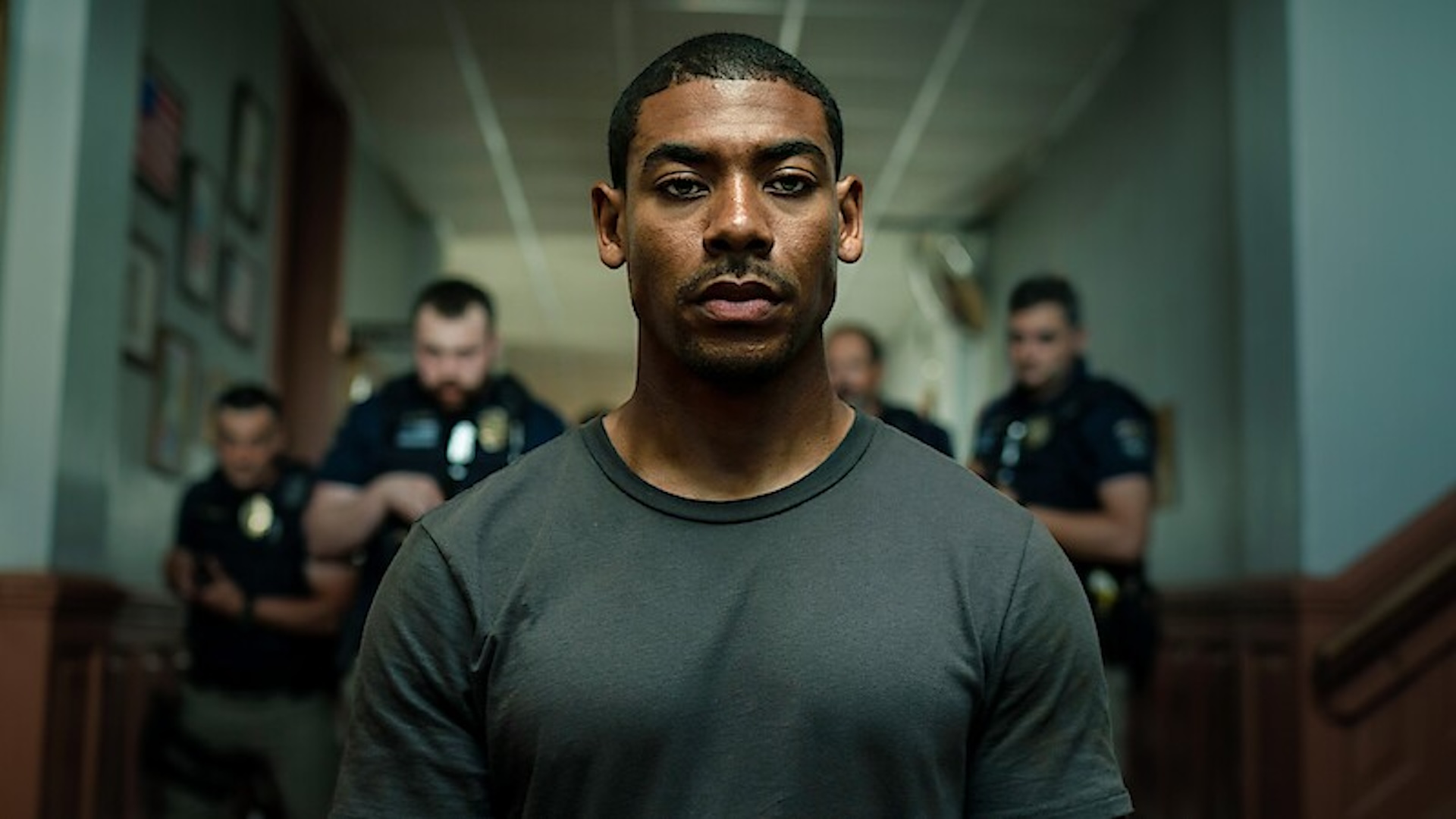It’s easy to forget just how impactful Get Out’s 2017 release was, not just for black filmmaking as an institutional concept, but for the often reiterated narrative elements. Foremost among these is the traffic stop, a mundane, deadly reality of black and brown life that, dramatized on screen, acts as a simple, effective tension builder. Sequences like the traffic stop have rigidly defined beats. There’s the preamble to the police showing, swerving into view like a shark, when a character is driving or walking in oblivious peace. And then the flare of the light bar or the siren, the moment when the character looks over their shoulder, pulls off to the side, and that long, slow, luxuriating walk the officer takes from his vehicle.
It’s not usually termed as such, but there’s an exploitative element to the on-screen traffic stop. The expectation of the traffic stop’s outcome conjures to mind death, grievous injury, or, at the very least, rank injustice. It’s why these sequences tend to come at the beginning of a movie or show—to set up the stakes, sure, but also to gesture towards the seriousness with which its filmmakers wish an audience to take the material unfolding, no matter how cartoonishly evil the cops act, no matter how maudlin the appeals to innocence and unfairness espoused by the victim. Suffice it to say, this kind of thing has gotten old.
How refreshing, then, to see what can be done when a director utilizes these very same elements, in the same order, with the same beats, as a means of familiarizing an audience with a film’s cinematic language, with its characters and their behaviors, and still manage to wring a new feeling from it. Jeremy Saulnier’s thriller Rebel Ridge opens with black veteran Terry Richmond (Aaron Pierre) biking into the Louisiana town of Shelby Springs, being silently trailed by a patrol vehicle, and then deliberately rammed off the road. As one car pulls over ahead of him, another suddenly appears, the familiar tactical wariness espoused by cops shown for what it always is: overkill.
Richmond, cutting a tall, muscular figure, understands that prowess and strength are useless in these situations. As for Saulnier, he grasps what so few filmmakers do: the fact that cops need not be bald about their racism or narcissism in order to be imposing, brutish, even evil. The law is on their side, including all manner of bureaucratic minutiae, which is what both cops hit Richmond over the head with rather than verbal bigotry. The audience can sense the unstated vitriol simmering beneath the ostensibly proper procedure of due process, but Saulnier doesn’t capitulate to the tired framing of sneering white cops parading around like jesters. Rather, he shows them as trigger-happy, paranoid, highly suggestible stooges that are dangerous precisely because they’re stupid.
When the cops search Richmond, they find over $30,000 in cash in his backpack, money he plans to use to bail out his cousin, Mike Simmons, who was arrested for possession of marijuana. Mike’s previous run-in with a gang higher-up ensures a death sentence if he’s successfully transferred to state prison. The cops don’t heed any of this, not the legal provenance of the money nor its intended use. Instead, they seize it and assure Richmond that if he’d like to sue for his property back, the lengthy legal process would be costly and time-consuming. Richmond becomes just another victim of civil asset forfeiture, and goes on to spend the first third of the movie in conflict not with racist hillbilly cops, but with the bureaucracy and complacency of a small town’s rotting justice system.
As Richmond soon learns, the Shelby Springs police department has been seizing assets during their arrests and funneling the money into the department’s budget. The surplus goes right back into the community, a local racket that every resident benefits from, thus making everyone complicit. Police Chief Sandy Burnne (Don Johnson), all smiles and self-assuredness, claims to have welcomed the national reformist wave brought on in the wake of George Floyd’s murder. In truth, policies meant to provide oversight and accountability with the police have, in the case of Shelby Springs, turned the police department into a rogue outfit. Without ever losing the propulsion of an action movie, the middle third of Rebel Ridge becomes a complex political thriller, in which the maddening details of what’s actually going on in Shelby Springs are discovered, and reveal a police department that’s very survival is predicated on its ability to efficiently and silently prey on the town.
Anyone familiar with the direct-to-video action films of Jesse V. Johnson will take to Rebel Ridge’s premise, one that takes great care in its depiction of physical and existential violence. It’s clear that Richmond harbors a well-kept secret. In the first third of the film, as he tries to file a police report against the officers who stole his money, then, when that fails, tries to make a deal with Chief Burnne, then, when that fails, tries to find out more about what’s really going on in Shelby Springs, the audience senses a reveal brewing. In each case, when Richmond is repeatedly stonewalled, and he stands tall, patiently listening to officials who think they’re not only smarter but more capable than he is, the expectation of a punch or a kick only builds.
When violence does finally come, Saulnier directs each sequence with a detail and brevity that recalls the Coen brothers at their most kinetic. We’re talking about thrilling, realistic hand-to-hand combat with a real element of danger, yes, but also a character in Richmond whose experience utilizing it isn’t so black-and-white. Where First Blood, one of Saulnier’s avowed influences, depicts a veteran returned home and haunted by the combat he witnessed in Vietnam, Rebel Ridge shows us a former soldier who was never actually deployed. This doesn’t make Richmond any less dangerous, but his methods—surgical, brutal, and tellingly non-lethal—differentiate him from the many bloodthirsty revenge heroes that populate the genre. For Richmond, who is no sop for the armed forces and not always the best judge of character, the freedom of his cousin is the ultimate goal. It is a pure and uninflected mission, one that is halted by neither flashback nor saccharine backstory.
Indeed, one of Rebel Ridge’s many pleasures is Saulnier’s talent, on full display in his previous films Blue Ruin and Green Room, for narrative momentum. Saulnier’s scripts are motivated by character before anything else, which allows for behavior to affect plot. Much like Michael Clayton, another major cinematic comparison, Rebel Ridge is as apt to wring tension from a fax being sent as a gun being loaded. That’s because, for Saulnier and for his story, both elements hold equal weight. What’s so refreshing about Rebel Ridge is the degree to which its protagonist is trying his hardest not to resort to violence, and when that violence does come, how messy and drawn-out it can be. This penchant for non-lethal combat, which shouldn’t be mistaken for meekness, doesn’t come from a core of goodness, though Richmond does appear to be the kind of person for whom virtue is sacred, but because violence only slows things down.
None of this—not Rebel Ridge’s righteous disdain for the police, not its narrative stops and starts, not its most compelling action sequences—would work without Pierre, whose performance is by turns steely, vulnerable, and, most important for any action film worthy of posterity, full of quiet humor. Saulnier peppers Rebel Ridge with memorable one-liners, a risky move in the wake of the spreading infection of Marvel’s quip-heavy excuse for humor. But Pierre delivers them smoothly, without any embarrassment and, crucially, Saulnier lets them stand alongside the film’s best moments. At one point, Pierre unloads a shotgun, shucking shells onto the ground in rapid succession, before throwing the whole weapon at a cop and knocking him out. It’s the kind of iconic, simple moment ‘80s and ‘90s action films used to be filled with, the kind sorely missing from any of the action films, including and especially the John Wick franchise, made in the last decade.
As I watched the film, as I watched Pierre’s confident, cool (in every sense of the word) embodiment of Richmond as a man driven by justice but also honor and camaraderie through action, I was reminded that the on-screen vigilante, exemplified in its most basic and sometimes least convincing form in the prototypical Western, is the knight of our era. It’s difficult not to think of Richmond as a character this way, a former arm of the government, marked by his service, yet sent wayward by his duty to others.
This framing would be uncomfortable if it wasn’t made clear by Saulnier at every turn that there is little in Rebel Ridge meant to glorify the military or the police. Late in the film, one of Richmond’s staunch allies turns out to be, ostensibly, an enemy of the United States. Richmond’s tattoo signifying his time in the Marines acts more as a marker of the past than any present or future. Pierre imbues Richmond with a knowing skepticism of the veracity of the law. It’s less that he believes the law is useless than that he understands the law is, by design, only meant to work for certain people. When he finally starts kicking ass, the feeling isn’t completely triumphant, though Saulnier indulges in the satisfying catharsis of a good third-act showdown. There’s a bit of disappointment in it, unsurprised but let down nonetheless.
Ultimately though, Rebel Ridge’s success comes down to perhaps the least interchangeable facet of the film: Richmond’s blackness. Lesser directors have made the racial makeup of their protagonists fodder for tiring exposition and self-indulgent monologues supposedly included for the benefit of the culture. This kind of chest-puffing pride belies a belief that change might be made by depicting triumph as a necessary corrective to so much black erasure and death. As Angelica Jade Bastien wrote recently in an essay on the white supremacist fantasy of the Reacher series, “After 9/11, the media reconstituted itself. Blackness was no longer used as a marker of countercultural cool; instead, Black people — but particularly Black men — became the face of institutions in a united-we-stand era from which we have yet to escape. They became police officers, lawyers, judges, and government workers in The Wire and beyond. In making Black people the face of the empire, shows and movies could garner diversity points while also projecting faith in systems that constrain the possibilities of Black life.”
Saulnier goes the other way, allowing Richmond’s blackness to become an integral contributing factor to his inability to trust in the institutions he has no choice but to interact with, all while remaining intensely, specifically his own character. There’s no shortage of rage at the core of Rebel Ridge, but it’s tempered by the knowledge, explicitly communicated throughout, that a concatenation of systemic biases, including racism, are what repeatedly keep people poor, in jail, and addicted. And, lest a late twist in the third act seem as if Saulnier is reneging on his withering critique of the police, it’s important to remember what it means when an individual chooses to extract himself from the cancerous enterprise he was once a part of. In other words, people with good intentions can choose to become cops, but their goodness doesn’t alter the sickness at the heart of the profession. In Rebel Ridge’s final moments, when Richmond storms the castle and mounts his last stand, Saulnier shows how much more powerful a statement against corruption can be when it isn’t made alone.






